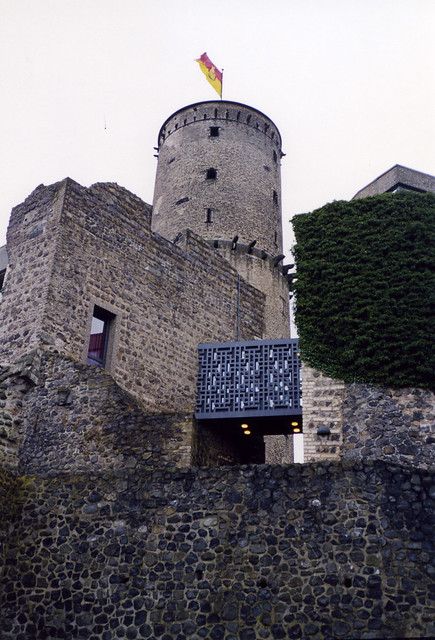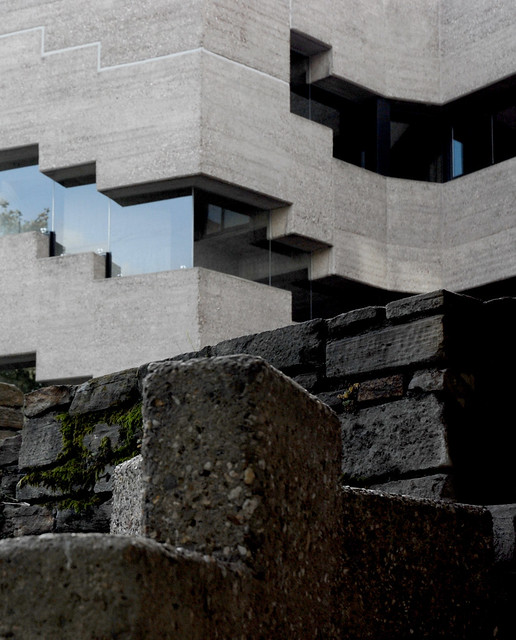 let's start with Gottfried Böhm: last summer he seemed to be everywhere. to be honest 'everywhere' mostly consisted of someone at work mentioning him once and me reading about his Bensberg Town Hall (1962-67) in Peter Blundell-Jones and Eamonn Canniffe's Modern Architecture Through Case Studies 1945-1990 (a book I bought mostly because it featured said Magistero). the Town Hall is a concrete building set within the remains of a medieval castle and was so intriguing that the next time I found myself in a well-stocked bookshop I ended up buying a monograph on Böhm.
let's start with Gottfried Böhm: last summer he seemed to be everywhere. to be honest 'everywhere' mostly consisted of someone at work mentioning him once and me reading about his Bensberg Town Hall (1962-67) in Peter Blundell-Jones and Eamonn Canniffe's Modern Architecture Through Case Studies 1945-1990 (a book I bought mostly because it featured said Magistero). the Town Hall is a concrete building set within the remains of a medieval castle and was so intriguing that the next time I found myself in a well-stocked bookshop I ended up buying a monograph on Böhm. through the monograph I found out not only that Böhm had done other projects in a similar vein – the first seems to be a hotel and restaurant in Bad Godesberg outside Bonn (1959-68) – but also that he designed a chapel on the site of Peter Zumthor's Kolumba Museum (1997-2007), a chapel now incorporated into the new museum. so let's take a look at these buildings and their attitudes to adaptations of older buildings*:
through the monograph I found out not only that Böhm had done other projects in a similar vein – the first seems to be a hotel and restaurant in Bad Godesberg outside Bonn (1959-68) – but also that he designed a chapel on the site of Peter Zumthor's Kolumba Museum (1997-2007), a chapel now incorporated into the new museum. so let's take a look at these buildings and their attitudes to adaptations of older buildings*:in Bad Godesberg** Böhm unceremoniously places his modern additions on and in-between existing wall fragments. while the original walls are of stone Böhm's additions are in fair-faced concrete, neither entirely breaking with nor blending in with the old ruins. in this way Böhm creates not a brand new building but an amalgamation: the new spaces are partly created by what built matter was already on the site. at the same time Böhm adhered to the often used modernist strategy of clearly separating the existing building and any new interventions: what is modern is undoubtedly modern: there is no mimicking of traditional forms or detailing.
Böhm used the same approach in his competition-winning entry for the Bensberg Town Hall***, although in a more extreme version. the old castle in Bensberg had been a ruin since the Thirty Years' War but in the mid-eighteenth century the ruin was converted into a monastery and later on also into a hospital. Böhm decided to get rid of these fairly recent structures and to only keep the medieval remains. in this way he had a podium of lower walls as well as one higher fragment curving around and protecting part of the site. the higher part of the wall ended in a high tower with a slate roof which he also retained. Böhm placed the council chamber against the higher wall fragment while placing all other accommodation in a C-shaped pattern around a courtyard open to the town. in this way the position of the council chamber, the complex's most important room, was shown to the surrounding town by the tower and from the building's courtyard by extensive glazing, two stories high.
 once again the interventions are modern, to say the least. the fenestration is in the form of ribbon windows thus clearly breaking with the romanesque windows of the original building (some of which were re-created from archaeological findings). in the more important parts - the stair tower and on the ground floor - the glazing is frameless which must be considered very advanced for the mid 60s.
once again the interventions are modern, to say the least. the fenestration is in the form of ribbon windows thus clearly breaking with the romanesque windows of the original building (some of which were re-created from archaeological findings). in the more important parts - the stair tower and on the ground floor - the glazing is frameless which must be considered very advanced for the mid 60s.just as in Bad Godesberg the junctions between new and old parts are not expressed in any particular way, rather new and old are juxtaposed with concrete simply sitting atop older stone walls.
after the allied bombing of Cologne during the Second World War most parts of the church of St. Kolumba had been demolished but left standing was a medieval statue of the Virgin Mary. in 1948 Böhm built a chapel to protect the statue and in 1956 he added a sacristy along with a boundary wall to the monastery just north of the chapel.
 in 1997 there was a competition for a new diocesan arts museum on the site of the old church where Böhm participated. Böhm didn't win, instead the victory went to Peter Zumthor. in a move very reminiscent of Böhm Zumthor's proposal places new walls directly on to the structures already present on the site, be they medieval masonry or Böhm's post-war concrete walls. these new walls are made of a brick Zumthor developed especially for the project: a thin long slab hinting at both old Roman brickwork and at the masonry employed in his Therme Vals. in a way these brick walls become a mediation between the different periods already represented on the site: the detailing of the brickwork is very abstract hinting at modernity but in no way does it seem more modern than Böhm's 1956 concrete walls, rather the opposite. in this I think Zumthor has managed to strike a perfect note, the additions are clearly marked out as such but also function as a backdrop highlighting both the ruinous fragments and Böhm's structures as parts of special interest.
in 1997 there was a competition for a new diocesan arts museum on the site of the old church where Böhm participated. Böhm didn't win, instead the victory went to Peter Zumthor. in a move very reminiscent of Böhm Zumthor's proposal places new walls directly on to the structures already present on the site, be they medieval masonry or Böhm's post-war concrete walls. these new walls are made of a brick Zumthor developed especially for the project: a thin long slab hinting at both old Roman brickwork and at the masonry employed in his Therme Vals. in a way these brick walls become a mediation between the different periods already represented on the site: the detailing of the brickwork is very abstract hinting at modernity but in no way does it seem more modern than Böhm's 1956 concrete walls, rather the opposite. in this I think Zumthor has managed to strike a perfect note, the additions are clearly marked out as such but also function as a backdrop highlighting both the ruinous fragments and Böhm's structures as parts of special interest.though Böhm himself have expressed reservations against Zumthor's project it seems the major difference between Kolumba and the Böhm projects I've discussed above is the fact that Böhm was still alive when Zumthor's project was built. apart from that it uses pretty much the same strategies regarding retention and interventions on sites already rich with history. I guess if there's one major difference it is that where Böhm at Bad Godesberg and Bensberg create a true collage from two equally important parts – what's existing and what's new – Zumthor's new structure is so much larger and more important than the older parts it feels as if it's about to devour them. if this is down to a different attitude or just a reflection of the size of the programme he had to fit on to the site I'm not sure.
* I probably should mention I haven't visited any of the buildings but rather have to rely on drawings, photos and other people's accounts.
** some more photos of Bad Godesberg can be found here
***and some very good ones of Bensberg can be found here
acknowledgements: both of the beautiful photos of Bensberg are stolen from SEIER+SEIER, photo of Bad Godesberg by TRiver
photo of Kolumba by Claus Moser

